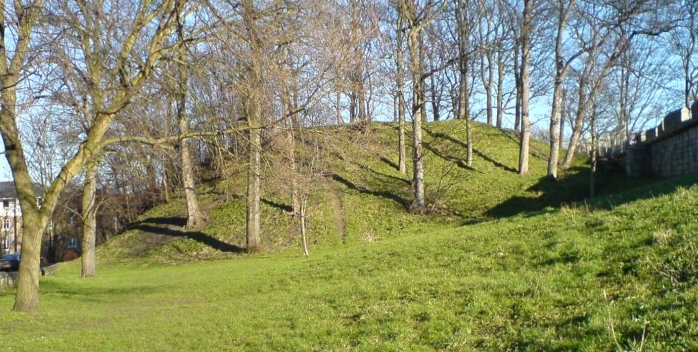Baile Hill, York on:
[Wikipedia]
[Google]
[Amazon]
 Baile Hill is a man-made earth mound in the
Baile Hill is a man-made earth mound in the
An article reporting on the 1968 archaeological excavation of Baile hill from Current Archaeology magazine, No. 12, January 1969
{{coord, 53.95394, -1.08291, type:landmark_region:GB, display=title Buildings and structures in York Castles in North Yorkshire
Bishophill
Bishophill is an area of central York, in England. It lies within the city walls and has been occupied since at least the Roman period.
Etymology
Known as "Bichill" by 1334, the name was also recorded as "Bychehill Lomelyth", "Lomelyth" being ...
area of York
York is a cathedral city with Roman origins, sited at the confluence of the rivers Ouse and Foss in North Yorkshire, England. It is the historic county town of Yorkshire. The city has many historic buildings and other structures, such as a ...
, England. It is the only remaining feature of what was known as the Old Baile.
The origins of Baile Hill date back to 1068. Having seized York in that year, William the Conqueror
William I; ang, WillelmI (Bates ''William the Conqueror'' p. 33– 9 September 1087), usually known as William the Conqueror and sometimes William the Bastard, was the first House of Normandy, Norman List of English monarchs#House of Norman ...
built a castle on the south side of the city close to the River Ouse. Then, as a response to a rebellion the following year, a second castle was built on the opposite side of the river. There is no clear evidence which of these castles was built first, but it is generally thought to be the one which stood on the site of the later York Castle
York Castle is a fortified complex in the city of York, England. It consists of a sequence of castles, prisons, law courts and other buildings, which were built over the last nine centuries on the south side of the River Foss. The now-ruined ...
on the east side of the river, followed by the Old Baile on the west side.
Like its opposite counterpart, the Old Baile was of motte and bailey design. The motte was approximately 40 feet (12 m) high and 180 feet (66 m) in diameter, and was surrounded by a large ditch. A flight of steps led to a wooden structure at the top which was surrounded by a fence, also made of wood. The bailey lay to the north-west of the motte and was rectangular. Around its perimeter was an earth rampart and an outer ditch.
The castle, it is believed, was not in regular use for long. By the 13th century it was in the hands of the Archbishop of York
The archbishop of York is a senior bishop in the Church of England, second only to the archbishop of Canterbury. The archbishop is the diocesan bishop of the Diocese of York and the metropolitan bishop of the province of York, which covers th ...
and in 1322 Archbishop Melton agreed to defend it in times of war. By part of the city wall
A defensive wall is a fortification usually used to protect a city, town or other settlement from potential aggressors. The walls can range from simple palisades or earthworks to extensive military fortifications with towers, bastions and gates ...
had been built along the south-east and south-west sides of the Old Baile, incorporating the existing ramparts and ditch, however, these defences were rarely called into use. The only notable occasion was the siege of York
The siege of York in 1644 was a prolonged contest for York during the First English Civil War, between the Scottish Covenanter army and the Parliamentarian armies of the Northern Association and Eastern Association, and the Royalist A ...
in 1644 during the Civil War
A civil war or intrastate war is a war between organized groups within the same state (or country).
The aim of one side may be to take control of the country or a region, to achieve independence for a region, or to change government policies ...
, when Baile Hill was used as a royalist
A royalist supports a particular monarch as head of state for a particular kingdom, or of a particular dynastic claim. In the abstract, this position is royalism. It is distinct from monarchism, which advocates a monarchical system of governm ...
gun emplacement. Apart from that, however, the Old Baile was used mainly for grazing and recreation activities, particularly archery during the medieval
In the history of Europe, the Middle Ages or medieval period lasted approximately from the late 5th to the late 15th centuries, similar to the post-classical period of global history. It began with the fall of the Western Roman Empire ...
period.
Today, Baile Hill stands at the junction of Baile Hill Terrace and Cromwell Road. The only other visible evidence of the former castle are two slight dips in the city wall rampart, one next to Baile Hill and the other close to Victoria Bar, which indicate the location of the former ditch. Houses built during the 1880s cover the rest of the Old Baile.
References
An article reporting on the 1968 archaeological excavation of Baile hill from Current Archaeology magazine, No. 12, January 1969
{{coord, 53.95394, -1.08291, type:landmark_region:GB, display=title Buildings and structures in York Castles in North Yorkshire